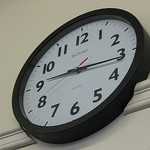"Time" on task
By Mary Bigelow
Posted on 2014-09-29
 I’m a new high school teacher looking for suggestions on how to estimate the amount of time a lesson will take. My lessons look good when I plan them, but I find that often a lesson is either too short and we have extra time at the end of the class or I run out of time to complete the activity or get to everything I wanted to do. I’m a beginning high school teacher looking for suggestions on how to estimate the amount of time a lesson will take.
I’m a new high school teacher looking for suggestions on how to estimate the amount of time a lesson will take. My lessons look good when I plan them, but I find that often a lesson is either too short and we have extra time at the end of the class or I run out of time to complete the activity or get to everything I wanted to do. I’m a beginning high school teacher looking for suggestions on how to estimate the amount of time a lesson will take.
—H. from Minnesota
I wish I had an algorithm to share for estimating time for class activities, but there are many variables involved: the number of questions students have, the amount and depth of discussion, interruptions and distractions, equipment or technology issues, time spent on classroom management, and digressions for “teachable moments.”
For teaching several sections of the same class, I found it helpful to keep them near the same pace, within reason, for planning lab investigations or assignment due dates. It didn’t help that some of the class periods in my school were 40 minutes and others were 45! Due to school events, there were days when I did not meet with all of my classes. There also were days when activities were completed quickly in some classes and dragged on in others.
At the end of each class, annotate your plans with what students were able to accomplish and any issues that arose. The next time you plan this lesson, you’ll be better able to determine how much time to allow. You’ll see that many lessons will take more than one class period.
You may find it necessary to spend time on extra discussion or to slow the pace if students are struggling or need assistance. But you can maximize productive class time by establishing and using routines. When students come into the classroom, they could follow a bell-ringer activity to get them ready and focused for class. With routines in place, students should know how to transition between activities, how and where to get materials, and what to do when disruptions happen.
If the students complete activities ahead of time, it’s not good to give them “free” time for socializing. This could reinforce the idea of rushing through an activity just to get finished. Use extra time to continue student learning with additional discussion, review, readings, journaling, or moving ahead to the next topic or task.
Here are some suggestions from an NSTA forum on the topic:
- Carolyn: I have learned to always overplan. It is okay to not get through everything, but it is never okay to finish early and waste valuable student learning time. I am always thinking of ways to check for understanding along the way. Perhaps having a few formative assessment strategies ready to go will serve as appropriate and useful “fillers” when you find a lesson taking a lot less time than you expected.
- Betty: One thing I would do if the lesson was too short is to have a couple of quick verbal games related to the subject areas to play with the students to fill in the time and reinforce the concepts.
- Alyssa: When trying to manage my time, I use a technique that I learned in my reading class. We learned that we should make a rough estimate of how long each particular section of the lesson would take. Once you have an estimate of the amount of time the lesson should take, plan accordingly and keep your eye on the clock to make sure that you’re not running out of time or rushing the lesson.
- Tina: I also left a day every two or three weeks where I did not plan a lesson and used that as my personal make-up day to try to catch up my lesson plans with the calendar. If, by some miracle, we were on track and on time, that day became a general review day and we would play science basketball, or chemistry bingo, or some science game, or we would watch a short video that tied in with the topic we were covering.
- William: It seems like student assessment of some kind should drive when a lesson is considered complete—one challenging aspect of this is making sure there is somewhere deeper to go, or some extension application that you can fall back on if the whole class or particular students demonstrate completing a lesson earlier than expected. For me anyway, it’s never the whole class that finishes earlier than expected, but often individual students who do.
Trying to stay on a rigid timetable, especially if you teach more than one section of a course, is futile! You’ll find that with more experience, you’ll be better able to determine an appropriate time range.
Photo: https://www.flickr.com/photos/cgc/7080721/sizes/q/
Disclaimer: The views expressed in this blog post are those of the author(s) and do not necessarily reflect the official position of the National Science Teaching Association (NSTA).


